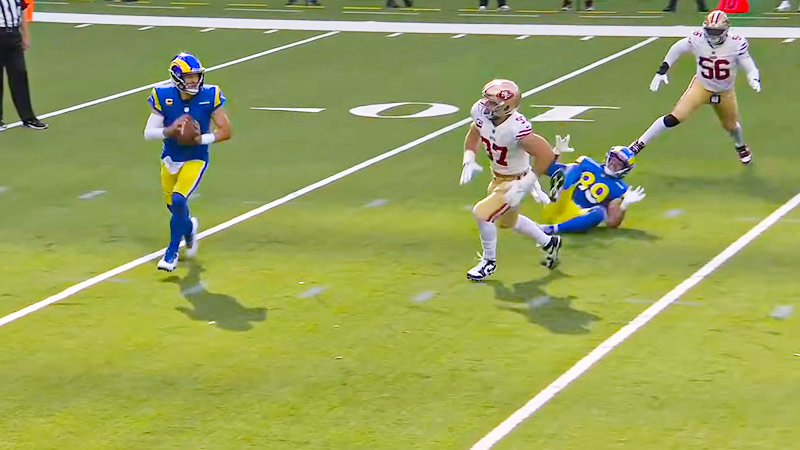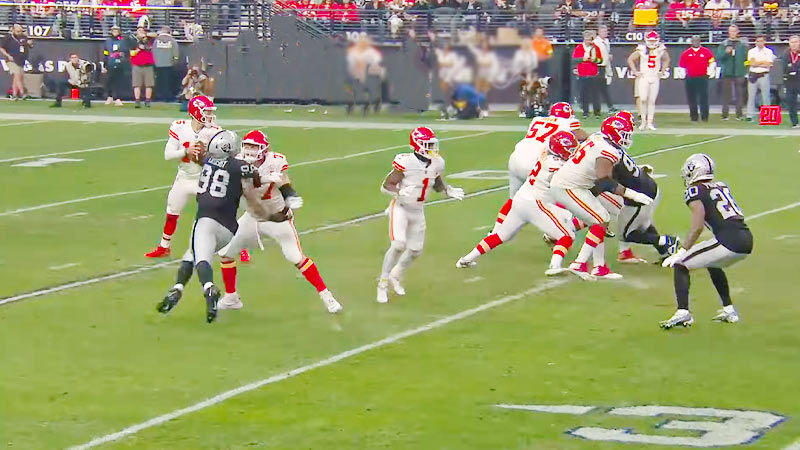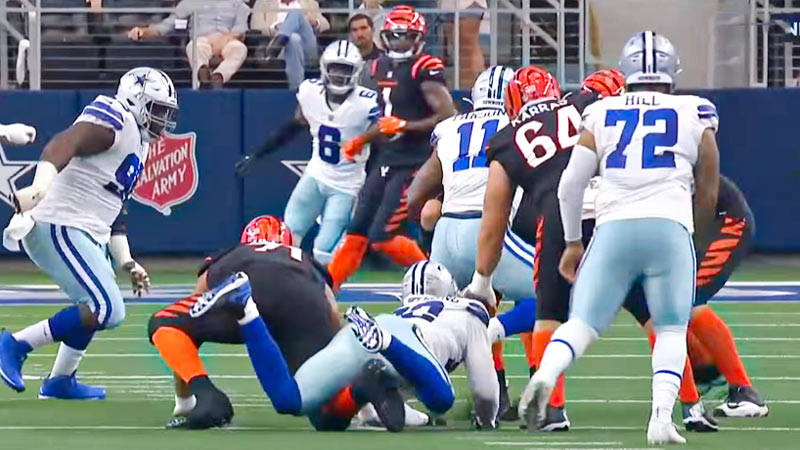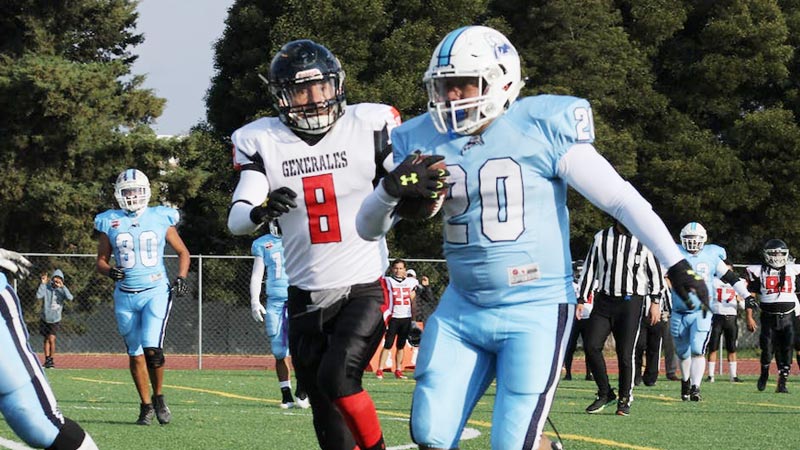In the intricate dance of strategy and athleticism that is football, the 2nd down holds a pivotal role. As the second phase of a team’s four-down sequence, this moment encapsulates the essence of football’s tactical brilliance.
It’s a moment when coaches and players alike must make critical decisions that could shape the outcome of the game.
In this blog post, we delve into the intricacies of the football 2nd down, shedding light on its significance, strategies, and impact on the field. So, stay focused.
What Is Football 2nd Down?
The second down in football is the second phase of a team’s offensive sequence, consisting of four downs. In the game of American football, the field is divided into yards, and each team has four opportunities, or downs, to advance the ball ten yards.
The ultimate objective is to reach a new set of four downs by covering these ten yards, commonly referred to as achieving a “first down.” When a team starts its offensive possession, it’s given the first down.
If, after the first play, the offense manages to advance the ball a minimum of ten yards or more, they successfully gain a first down, resetting their downs to four. However, if they don’t manage to reach the ten-yard threshold on the first play, they move on to second down.
The second down occurs when the offense has another chance to progress toward the first down marker. The team has three more downs (plays) to cover the remaining distance to gain a first down.
Distance Between the 1st and the 2nd Down in Football

The distance between the 1st and 2nd down in football is determined by the outcome of the first play in a team’s offensive possession. If the offense fails to cover the required ten yards for a first down on the initial play, they proceed to the 2nd down.
The yards left to achieve a first down on 2nd down are influenced by the distance covered on the previous play. For instance, if the offense advances five yards on the 1st down, they will face 2nd down and five yards to go for a first down.
The transition from 1st to 2nd down marks the continuation of the offensive sequence, presenting the team with another opportunity to advance and secure a fresh set of downs.
Primary Goal of the Offense on the 2nd Down
On the 2nd down in football, the offense faces a crucial juncture in advancing toward a first down. The primary goal of the offense during this phase is to strategically position themselves for a manageable 3rd down situation or potentially secure a first down.
Progress Toward First Down
The offense aims to gain significant yardage on the 2nd down to bring them closer to the first down marker. Successfully covering a substantial portion of the remaining distance makes the upcoming 3rd down more manageable, increasing the likelihood of extending their possession.
Strategic Playcalling
Offensive coordinators strategically select plays that exploit the defense’s tendencies, aiming to exploit any weaknesses or mismatches. The 2nd down presents an opportunity to choose plays that could put the offense in a favorable position for the subsequent downs.
Balance and Flexibility
Maintaining a balanced offensive approach helps keep the defense guessing. The offense might opt for either a running or passing play, depending on the situation. Achieving balance ensures that the defense can’t anticipate the play call, potentially leading to greater success on the 2nd down.
Avoiding Negative Yards
Avoiding negative-yardage plays is crucial on the 2nd down. Losing yards could lead to an even longer distance on 3rd down, making it more challenging to secure a first down. Protecting the field position by gaining positive yardage is a key aspect of offensive strategy.
Setting Up Play Action
If the offense has effectively run the ball on the 1st down, the 2nd down can be a prime opportunity to set up a play-action pass. This involves faking a run to draw in the defense and then executing a pass play downfield, taking advantage of the defense’s anticipation.
How Field Position Influences 2nd-down Strategies?

Field position plays a significant role in shaping the strategies employed by an offense on the 2nd down in football.
The position of the ball on the field not only impacts the distance required for a first down but also guides the choices made by coaches and players in terms of play selection, risk-taking, and overall offensive approach.
Favorable Field Position
When the offense is closer to the opponent’s end zone, they might adopt a more aggressive approach on 2nd down. The shorter distance to the first down marker allows for a wider range of play options, including both running and passing plays.
The offense might aim to capitalize on potential scoring opportunities, such as attempting a deep pass or a quick-hitting run play.
Midfield Position
When the ball is around midfield, the offense is in a balanced position. The playbook remains open, enabling the team to choose plays based on the defense’s tendencies. Flexibility is key here, as a successful 2nd-down play can set up a manageable 3rd down and maintain offensive momentum.
Unfavorable Field Position
When the offense is deep within their own territory, the primary goal on 2nd down is often to create a more manageable 3rd-down situation and gain enough yardage for punting space.
Conservative playcalling might be favored to avoid turnovers or negative-yardage plays that could lead to safety situations or good field positions for the opposing team.
Red Zone Considerations
In the red zone, where the offense is close to the opponent’s goal line, the strategies on 2nd down can become more focused on capitalizing on scoring opportunities. Short-yardage passing plays or well-executed rushing plays might be utilized to exploit defensive vulnerabilities near the end zone.
Clock Management
The time remaining in the game can also influence 2nd-down strategies. If the offense is trying to score quickly, they might opt for more aggressive pass plays. On the other hand, if they are ahead and looking to run down the clock, they might choose conservative run plays to keep the clock running.
Defensive Considerations
Field position can also dictate how the defense lines up and reacts. The offense takes this into account when choosing plays on 2nd down. If the defense is playing deep to prevent big gains, short passes or screenplays might be more effective.
Conversely, if the defense is expecting a short gain, a well-timed deep pass might catch them off guard.
Tactics and Strategy of the 2nd Down

The 2nd down in football presents a pivotal opportunity for the offense to progress toward a first down and extend their possession.
Coaches and players employ a variety of tactics and strategies to optimize their chances of success during this crucial phase of the game.
Balanced Playcalling
Coordinators strive for a balanced mix of run and pass plays on 2nd down. This keeps the defense guessing and prevents predictability. The offense might opt for a quick, short-yardage pass or a well-timed run play to exploit defensive vulnerabilities.
Play-Action Pass
If the offense established a successful running game on the 1st down, they might use play-action on 2nd down. This involves faking a run to draw in the defense before launching a pass play. Play-action can catch defenders off guard and create opportunities for big gains.
Short Passes
Quick, accurate passes can help the offense gain positive yardage and set up a more manageable 3rd down situation. Screen passes, slants and quick outs are examples of effective short-passing options on 2nd down.
Intermediate Passes
Strategically timed intermediate passes (10-20 yards) can exploit gaps in the defense. These passes require precise timing and route running, potentially resulting in substantial yardage gains.
Varied Formations
Changing offensive formations can create mismatches and confusion for the defense. The offense might line up with multiple receivers or shift the tight end’s position to challenge the defense’s coverage schemes.
No-Huddle Offense
In situations where urgency is required, such as trying to catch the defense off guard, the no-huddle offense can be effective on 2nd down. It limits the defense’s ability to make substitutions and adjustments, potentially leading to advantageous matchups.
Targeting Weak Points
Studying the opponent’s defensive tendencies allows the offense to identify weak points to exploit. This could involve targeting a specific cornerback or attacking a particular area of the field.
Audibles and Adjustments
Quarterbacks and offensive captains often have the autonomy to change the play at the line of scrimmage based on defensive alignment. Audibles can help the offense exploit perceived weaknesses on 2nd down.
Misdirection Plays
Misdirection plays involve using deceptive actions to divert the defense’s attention. Reverses, end-arounds, and other trick plays on 2nd down can create confusion and potentially lead to substantial gains.
Conservative Approach
In certain situations, such as when deep within their own territory, the offense might opt for conservative plays on 2nd down to avoid turnovers and unfavorable field position.
Impact of Down and Distance in the 2nd Down

The combination of down and distance on the 2nd down in football profoundly influences a team’s offensive strategy and decision-making.
This critical factor dictates the available playbook options, potential risks, and overall approach to advancing toward a first down.
Distance to First Down
The remaining distance to achieve a first down on the 2nd down significantly influences playcalling. A shorter distance, such as 2nd and 2 (two yards to go), provides more flexibility for both run and pass plays.
A longer distance, like 2nd and 10 (ten yards to go), might lead to more passing plays to gain substantial yardage.
Balance of Run and Pass
The down and distance on 2nd down affect the balance between run and pass plays. A manageable distance might encourage the offense to run the ball, maintaining unpredictability. Conversely, a longer distance could prompt more passing attempts to cover ground quickly.
Play-Calling Creativity
The down-and-distance situation on 2nd down can dictate the creativity of play-calling. In short-yardage situations, teams might attempt trick plays or unconventional formations to catch the defense off guard.
Risk and Reward
The distance to a first down impacts the level of risk the offense is willing to take. In longer yardage situations, they might opt for safer, high-percentage plays to ensure some yardage gain. Shorter distances might invite riskier plays with higher potential rewards.
Field Position Consideration
Down and distance on 2nd down are closely linked to field position. Teams deep in their own territory might prioritize avoiding negative plays or turnovers, while those closer to the opponent’s end zone might aim for more aggressive play-calling to score.
Defensive Strategy Influence
The defensive approach can be influenced by the down and distance. Defenses might anticipate passing plays on longer distances, leading to more pressure on the quarterback. Shorter distances could prompt defenses to be more balanced in their coverage.
Efficiency for Third Down
A successful play on 2nd down that narrows the distance to a first down makes the subsequent 3rd down more manageable. The offense might aim to secure enough yardage to position themselves well for the following down.
Clock Management
The time remaining in the game can also affect playcalling. In situations where clock management is crucial, the offense might prioritize plays that keep the clock running, especially if they have a lead.
FAQs
What is the 2nd down in football?
The 2nd down is the second of four downs in a team’s offensive possession. If a team doesn’t reach the first down marker on their initial play, they enter the 2nd down phase. It’s a critical moment that influences subsequent plays and the overall strategy.
How does the distance to a first down affect playcalling on 2nd down?
The remaining distance to the first down marker greatly influences playcalling on the 2nd down. A shorter distance allows for a balanced mix of run and pass plays, while a longer distance might prompt more passing attempts to gain substantial yardage.
What role does field position play in 2nd-down strategies?
Field position is a key determinant in 2nd-down strategies. Teams closer to the opponent’s end zone might opt for more aggressive plays to score, while those deep in their own territory may prioritize avoiding negative plays or turnovers.
How do teams use play-action on 2nd down?
Play-action involves faking a run to draw in the defense before executing a pass play. Teams often use play-action on 2nd down, especially if they’ve established a successful running game, to catch defenders off guard and create passing opportunities.
How does the clock impact playcalling on the 2nd down?
The time remaining in the game can influence playcalling on the 2nd down. Teams looking to score quickly might opt for more aggressive pass plays, while those ahead might choose conservative run plays to manage the clock.
Wrapping Up
In the intricate chess match that is football, the 2nd down stands as a critical crossroads where strategy meets athleticism. Its impact on a team’s fortunes cannot be understated.
The choices made during this phase ripple through subsequent downs, and ultimately, shape the narrative of the game. Whether it’s the distance to a first down, the field position, or the clock ticking away, every factor paints a vivid canvas upon which the theater of football unfolds during the 2nd down.
As we’ve uncovered in this exploration, this seemingly unassuming moment holds the potential to change the course of a game and define the essence of football strategy. Best of luck.







